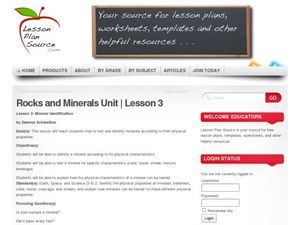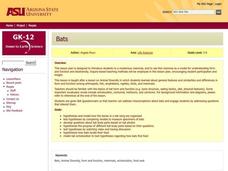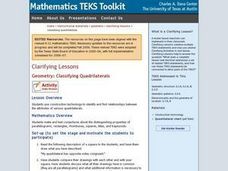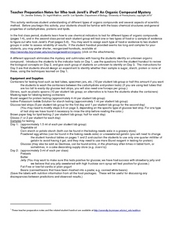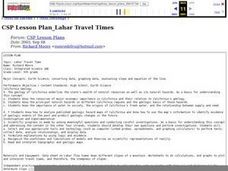Curated OER
Rocks and Minerals Unit
Students test and identify minerals according to their physical properties. In this mineral analysis lesson, students brainstorm ways to identify rocks and list their ideas on chart paper. Students study samples in pairs and identify the...
Curated OER
Mineral Identification
Eighth graders examine the properties that are used to identify minerals and how they work. In this investigative lesson students use the six properties to identify minerals that they are given.
Curated OER
Keep It Cool
Students complete a science experiment to study insulation, heat transfer, and permafrost. In this permafrost study lesson, students design and test a soda insulator. Students graph their class data and discuss the results. Students...
Curated OER
Curiosity Does Not Kill The Cat
Young scholars list the different ways they could test a guinea pig, a dandelion, and their brother (or sister)? They create a data chart in their group that lists the organism, what they could measure, and how they could change that...
Curated OER
How Do The Colors of Light Mix?
Students investigate the mixing of light. They form a hypotheses to reason why color changes occur and they write conclusions and ask new questions arising from the investigation. Students identify the primary and complementary colors of...
Curated OER
Sportsmanship and Spectator Behavior
Sixth graders listen to the story BEING A BAD SPORT as teacher reads to the class. They identify good and bad sportsmanship by reading and writing activities. They then go to the gym and simulate a game situation recording examples of...
Curated OER
What Is The Matter?
Students engage in a activity about the scientific concept of matter. They use essential questions in order to guide the research process. Students engage in several class inquiries that are hands on in order to investigate the...
Curated OER
SATP Basic Parts of an Informative Essay
Students identify the elements of an informative essay. Through a teacher led discussion, students explore the basic parts of a five paragraph essay and , using a hamburger as an analogy, students label the pieces. They discuss the...
Curated OER
Bats
Students model how the bones in a bat wing are organized. They develop questions about bat body parts based on photographs. They hypothesize how bats locate their food.
Curated OER
Geometry: Classifying Quadrilaterals
Students use construction technology to identify and find relationships between the attributes of various quadrilaterals. They make and test conjectures about the distinguishing properties of parallelograms, rectangles, rhombuses,...
Curated OER
The Ghost Particle
Students collect evidence to make inferences about a object hidden inside a sealed box. They think critically and logically to raise questions. Students identify questions that can be answered through investigation. They formulate and...
Curated OER
Bigger Better Bubbles
Students research different types of bubble gum and identify the variables in them. In this bubble gum instructional activity students design an investigation to test their hypothesis and graph their data.
Curated OER
Periodic Table
Students identify in what groups and periods element is, state how many valance electrons element has, list basic properties of groups on periodic table, fill electrons in correct energy level/groups, and answer chapter questions.
Curated OER
Who Took Jerell's iPod?
High schoolers investigate various substances to determine the perpetrator of a crime. In this biology lesson, students test for the presence of organic compounds in various samples. They identify an unknown substance based on its...
Curated OER
Diet Wars
Students watch the documentary "Diet Wars" and answer worksheet related questions on positive and negative influences on health and diet.
Curated OER
On The Move
Fourth graders solve basic mathematical problems. They identify and apply key terms and equations relative to physical science. They discuss how train engines use fuel to move a generator, which creates electrical current that moves...
Curated OER
Acceptance Sampling
In this algebra lesson, students sample food and identify acceptance sampling. They create specific plans to meet specific situations as they sample the food. There are 6 questions.
Curated OER
Water-holding Capacity of Earth Materials
Students design and conduct an experiment to test their ideas about how to speed up or slow down the rate of an enzyme-catalyzed reaction. They have access to an array of physical and chemical factors that might influence enzyme...
Curated OER
Food Forensics: A Case of Mistaken Identity
Learners develop an experiment to test a hypothesis. They use their knowledge of antigen-antibody specificity to develop a hypothesis. Students articulate that the antibody-antigen specificity is one part of the immune system. They...
Curated OER
Lahar Travel Time
Ninth graders analyze published geologic hazard maps of California and comprehend how to use the map's information to identify evidence of geologic events of the past and present and predict geologic changes in the future. They select...
Curated OER
Raising Buffalo
Fifth graders investigate the significance of buffalo in Native American society. In this Native American history lesson, 5th graders discuss construct a survey to identify what should be learned about buffalo and buffalo ranching....
Curated OER
How Effective is Perspiration at Cooling?
Students collect data on the cooling of water in two different test tubes, one that is wrapped in wet newspaper and one in dry newspaper. They then relate this cooling effect to the body's perspiration.
Curated OER
What are Properties of Wood?
Students use hands on scientific observation to determine characteristics of wood. They work directly with the materials and record their observations. Students test if wood absorbs water, if wood floats or sinks, and if all wood...
Curated OER
Sine and Cosine
Students solve problems using sine and cosine. In this precalculus lesson plan, students solve word problems using sine and cosine. They identify where it is appropriate to laws of sine and cosine and where to use the Pythagorean Theorem.
